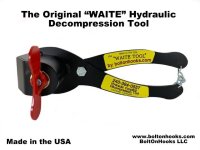K5lwq
Elite Member
- Joined
- Aug 6, 2017
- Messages
- 4,918
- Location
- Mineola, TX
- Tractor
- Kioti LK2554, Branson 4815C, Satoh Beaver, Speedex
You need to get the pressure off of the cylinders, not the lines. Use a jack to pick up on the frame of the backhoe. Once you get the weight off the outriggers, work the valve for the outriggers to equalize the line pressure. Then you should be able to connect the lines. If not, then you can work on relieving line pressure. Before trying to hook the lines up on the tractor, work the remote valves with tractor off.
To remove backhoe, use blocks as Richard suggests.
As Lou said, do not remove fittings to release pressure. This pressure is holding everything up. Also hooking lines together helps, but only if you don't leave weight on the cylinders.
To remove backhoe, use blocks as Richard suggests.
As Lou said, do not remove fittings to release pressure. This pressure is holding everything up. Also hooking lines together helps, but only if you don't leave weight on the cylinders.
Last edited:
